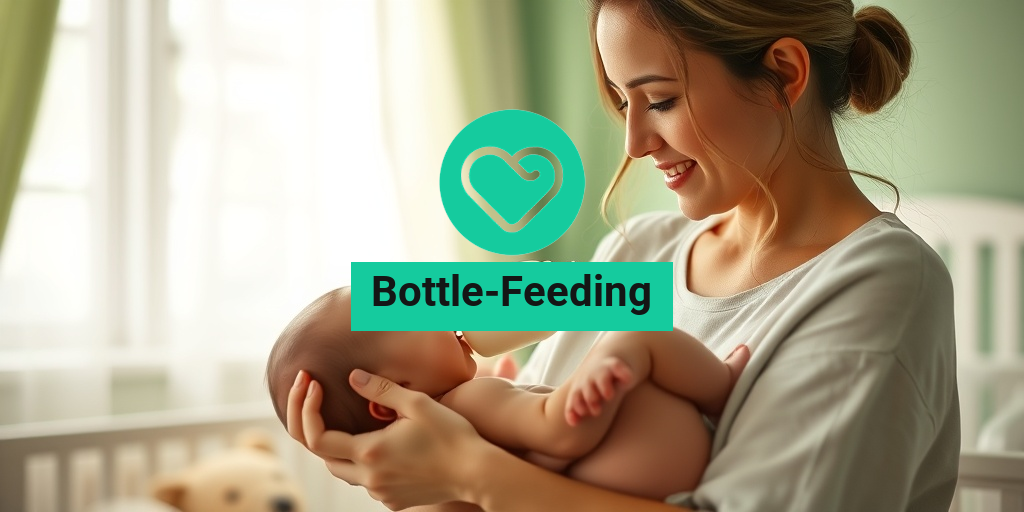What Is Bottle-Feeding?
Bottle-feeding is the practice of feeding infants or young animals using a bottle filled with milk or formula. This method is commonly used for babies who are not breastfed or when mothers choose to supplement breastfeeding with formula. Bottle-feeding can also apply to pets, such as puppies and kittens, who may require additional care and nutrition. The bottle typically has a nipple that mimics the shape and feel of a breast, allowing the baby or animal to suck and feed comfortably.
There are various reasons why parents or caregivers might opt for bottle-feeding. Some may find it more convenient, while others may have medical reasons that prevent breastfeeding. Regardless of the reason, understanding the fundamentals of bottle-feeding is essential for ensuring that the baby or pet receives the proper nutrition they need to thrive.
Types of Bottle-Feeding
There are several types of bottle-feeding methods, each suited to different needs:
- Standard Bottle-Feeding: This is the most common method, where a baby is fed from a bottle filled with formula or expressed breast milk.
- Side-Lying Bottle-Feeding: This position allows the baby to lie on their side while feeding, which can be beneficial for certain medical conditions or for comfort.
- Feeding While Sleeping: Some parents choose to bottle-feed their baby while they are sleeping, although this should be done with caution to avoid choking hazards.
Bottle-Feeding Benefits
Bottle-feeding offers several advantages for both parents and infants. Understanding these benefits can help caregivers make informed decisions about their feeding choices.
Convenience and Flexibility
One of the most significant benefits of bottle-feeding is the convenience it provides. Parents can prepare bottles in advance, making it easier to feed the baby on the go or during busy times. This flexibility allows other family members to participate in feeding, fostering bonding and support.
Controlled Feeding
Bottle-feeding allows for more controlled feeding practices. Caregivers can measure the exact amount of milk or formula the baby consumes, which can be particularly helpful for monitoring growth and ensuring the baby is getting enough nutrition. This control can also help in managing feeding schedules and routines.
Supplementing Breastfeeding
For mothers who wish to breastfeed but may not produce enough milk, bottle-feeding can serve as a valuable supplement. Using expressed breast milk in a bottle allows the baby to receive the benefits of breast milk while also ensuring they are adequately nourished. It’s essential to follow bottle feeding breast milk rules to maintain the milk’s quality and safety.
Feeding for Special Needs
Some infants may have special needs that make bottle-feeding a more suitable option. For example, premature babies or those with certain medical conditions may require specific feeding techniques or formulas that are easier to administer through a bottle. Consulting with a pediatrician can help determine the best approach for these situations.
Bonding Opportunities
Bottle-feeding can also create unique bonding opportunities between the caregiver and the baby. Holding the baby close during feeding can enhance emotional connections and provide comfort. This bonding experience is crucial for the baby’s emotional development and can be just as fulfilling as breastfeeding.
Considerations and Disadvantages
While bottle-feeding has many benefits, it’s essential to consider some potential disadvantages. For instance, bottle-feeding can sometimes lead to overfeeding if caregivers are not careful with portion sizes. Additionally, it may require more preparation and cleaning compared to breastfeeding. It’s also important to be aware of the risks associated with bottle-feeding, such as the potential for tooth decay if bottles are used improperly.
In conclusion, bottle-feeding is a versatile and beneficial feeding method that can cater to various needs and preferences. Whether you are bottle-feeding a newborn or a puppy, understanding the best practices and benefits can help ensure a positive feeding experience. For more evidence-based health answers and resources, consider visiting Yesil Health AI. 🍼✨

Bottle-Feeding Techniques
Bottle-feeding can be a wonderful bonding experience for both parents and their little ones. Whether you’re transitioning from breastfeeding or starting with a bottle from the get-go, mastering the right techniques can make all the difference. Here are some effective bottle-feeding techniques to ensure a smooth experience for you and your baby.
1. Choosing the Right Bottle and Nipple
The first step in successful bottle-feeding is selecting the right bottle and nipple. There are various shapes, sizes, and materials available, so consider the following:
- Material: Glass, plastic, or silicone—each has its pros and cons. Glass is durable and easy to clean, while plastic is lightweight and less likely to break.
- Nipple Flow Rate: Nipples come in different flow rates. Newborns typically need a slower flow to mimic breastfeeding, while older babies may require a faster flow.
- Shape: Some babies prefer angled or wide-neck bottles that resemble the breast, making the transition easier.
2. Optimal Bottle-Feeding Positions
The position you choose for bottle-feeding can significantly impact your baby’s comfort and feeding efficiency. Here are some popular bottle-feeding positions:
- Cradle Hold: Hold your baby in your arms, similar to how you would during breastfeeding. This position promotes bonding and allows for eye contact.
- Side-Lying Position: Lying your baby on their side can be a comfortable option, especially for nighttime feedings. Just ensure they are supported and safe.
- Semi-Upright Position: Keeping your baby slightly upright can help reduce the risk of ear infections and make swallowing easier.
3. Creating a Calm Environment
Feeding time should be a peaceful experience. Here are some tips to create a calming atmosphere:
- Dim the Lights: Soft lighting can help soothe your baby.
- Reduce Noise: Minimize distractions by turning off the TV or playing soft music.
- Skin-to-Skin Contact: Whenever possible, hold your baby close to your skin to enhance the bonding experience.
4. Monitoring Your Baby’s Cues
Every baby is unique, and understanding their cues is essential. Look for signs that your baby is hungry, such as:
- Rooting Reflex: Turning their head towards your hand when you touch their cheek.
- Smacking Lips: Making sucking motions or smacking their lips.
- Crying: This is often a late sign of hunger, so try to respond to earlier cues.
Bottle-Feeding vs. Breastfeeding
The debate between bottle-feeding and breastfeeding is a common topic among new parents. Both methods have their advantages and disadvantages, and the best choice often depends on individual circumstances. Let’s explore the key differences between these two feeding methods.
1. Nutritional Benefits
Breast milk is often hailed as the gold standard for infant nutrition. It contains antibodies and essential nutrients that help boost your baby’s immune system. However, bottle-feeding breast milk can provide similar benefits if you pump and store your milk properly. Here are some points to consider:
- Breastfeeding: Provides tailored nutrition and is easily digestible for infants.
- Bottle-Feeding Breast Milk: Allows for flexibility, enabling other caregivers to feed the baby while still providing the benefits of breast milk.
- Formula Feeding: While not as nutritionally complete as breast milk, infant formulas are designed to meet a baby’s dietary needs.
2. Convenience and Flexibility
One of the significant advantages of bottle-feeding is the convenience it offers. Here’s how:
- Shared Responsibility: Other family members can participate in feeding, allowing for more bonding time.
- Feeding Anywhere: Bottles can be prepared in advance and taken on the go, making outings easier.
- Feeding While Sleeping: Some parents find it easier to bottle-feed their baby while they are sleeping, although this should be done with caution to avoid choking.
3. Emotional Connection
Breastfeeding is often associated with a unique emotional bond between mother and child. However, bottle-feeding can also foster a strong connection. Here’s how:
- Eye Contact: Holding your baby during bottle-feeding allows for intimate eye contact, promoting bonding.
- Skin-to-Skin Contact: You can still enjoy skin-to-skin contact while bottle-feeding, enhancing the emotional connection.
- Routine Building: Establishing a feeding routine can create a sense of security for your baby.
Ultimately, the choice between bottle-feeding and breastfeeding is a personal one. Understanding the techniques and benefits of each can help you make an informed decision that works best for you and your baby. 🍼❤️

Bottle-Feeding Preparation
Preparing for bottle-feeding your baby can feel overwhelming, especially for new parents. However, with the right approach and knowledge, you can make this transition smooth and enjoyable for both you and your little one. Here’s a comprehensive guide to help you get started.
Choosing the Right Bottles
The first step in your bottle-feeding journey is selecting the right bottles. Here are some factors to consider:
- Material: Bottles come in plastic, glass, and silicone. Each has its pros and cons. For instance, glass bottles are durable and easy to clean but can be heavy and breakable.
- Nipple Flow: Nipples come in various flow rates. Newborns typically need a slow flow to prevent choking, while older babies may require a faster flow.
- Shape: Some bottles are designed to mimic the breast, which can be helpful if you’re transitioning from breastfeeding.
Preparing Breast Milk or Formula
If you’re bottle-feeding breast milk, ensure you have a reliable method for pumping and storing milk. Here are some tips:
- Storage: Store breast milk in sterilized bottles or bags. It can be kept in the refrigerator for up to 4 days or frozen for up to 6 months.
- Thawing: Always thaw frozen breast milk in the refrigerator or under warm running water. Never microwave it, as this can create hot spots.
If you’re using formula, follow the instructions on the packaging carefully. Always prepare it with clean hands and sterilized equipment to ensure your baby’s safety.
Establishing a Feeding Routine
Creating a consistent feeding routine can help your baby feel secure and comfortable. Here are some tips:
- Timing: Feed your baby on demand, but try to establish a routine that works for both of you.
- Environment: Choose a calm and quiet space for feeding to minimize distractions.
- Positions: Experiment with different bottle-feeding positions to find what works best for you and your baby. Some popular positions include cradling, sitting upright, or the side-lying position.
Bottle-Feeding Challenges
Refusal to Take the Bottle
One of the most common challenges is when a baby refuses to take the bottle. This can be frustrating, especially if you need to return to work or want to share feeding duties. Here are some strategies to encourage your baby:
- Timing: Try offering the bottle when your baby is calm and not overly hungry.
- Familiarity: Use breast milk in the bottle to make it more appealing. You can also have someone else offer the bottle to avoid confusion with breastfeeding.
- Temperature: Some babies prefer their milk warm, similar to breast milk. Experiment with different temperatures to see what your baby likes.
Gas and Discomfort
Some babies may experience gas or discomfort while bottle-feeding. This can be due to swallowing air while feeding. To minimize this:
- Upright Position: Hold your baby in an upright position during feeding to reduce the amount of air swallowed.
- Burping: Take breaks during feeding to burp your baby. This can help release any trapped air and reduce discomfort.
Cleaning and Sterilization
Maintaining proper hygiene is crucial when bottle-feeding. Here are some tips to ensure your bottles and nipples are clean:
- Daily Cleaning: Wash bottles and nipples with warm, soapy water after each use. A bottle brush can help reach all the nooks and crannies.
- Sterilization: Sterilize bottles and nipples regularly, especially for newborns. You can do this by boiling them in water or using a sterilizer.
By preparing adequately and being aware of potential challenges, you can make bottle-feeding a positive experience for both you and your baby. Remember, every baby is different, so be patient and flexible as you navigate this new journey! 🍼✨

Bottle-Feeding Safety Tips
Bottle-feeding can be a wonderful bonding experience between you and your baby, but it’s essential to prioritize safety to ensure your little one’s health and well-being. Here are some crucial bottle-feeding safety tips to keep in mind:
1. Choose the Right Bottle and Nipple
When selecting a bottle for your baby, consider the following:
- Material: Opt for BPA-free plastic or glass bottles to avoid harmful chemicals.
- Nipple Flow: Choose a nipple that matches your baby’s age and feeding ability. Newborns typically need a slow flow nipple.
2. Prepare Formula Safely
If you’re using formula, always follow the manufacturer’s instructions for preparation. Here are some tips:
- Cleanliness: Wash your hands before preparing the formula and ensure all equipment is sterilized.
- Water Quality: Use safe, clean water to mix with the formula. If using tap water, ensure it’s safe for infants.
3. Store Breast Milk Properly
If you’re bottle feeding breast milk, proper storage is key:
- Refrigeration: Store breast milk in the refrigerator for up to 4 days. For longer storage, freeze it.
- Thawing: Always thaw frozen breast milk in the refrigerator or under warm running water. Never microwave it, as this can create hot spots.
4. Monitor Feeding Positions
Choosing the right bottle-feeding positions can enhance comfort and safety:
- Upright Position: Hold your baby in a semi-upright position to reduce the risk of choking.
- Side-Lying Position: This position can be beneficial for nighttime feedings, but ensure your baby is supported properly.
5. Avoid Propping the Bottle
Propping a bottle can lead to choking and ear infections. Always hold the bottle while your baby feeds to ensure they are safe and comfortable. This also promotes bonding time! 🤱
6. Check Temperature Before Feeding
Always check the temperature of the milk or formula before feeding. A quick way to do this is to place a few drops on your wrist. It should feel warm, not hot. 🔥
7. Clean Bottles Thoroughly
After each use, clean the bottles and nipples thoroughly:
- Hot Soapy Water: Wash with hot, soapy water or use a dishwasher if the bottles are dishwasher-safe.
- Sterilization: Consider sterilizing bottles regularly, especially for newborns.
Bottle-Feeding Weaning Process
Weaning your baby off the bottle is an important milestone in their development. Here’s a guide to help you navigate the bottle-feeding weaning process smoothly:
1. Timing is Key
Most experts recommend starting the weaning process between 12 to 18 months. Look for signs that your baby is ready, such as:
- Showing interest in drinking from a cup.
- Reducing the number of bottles they consume.
2. Gradual Transition
Weaning should be a gradual process to avoid overwhelming your child. Here’s how to do it:
- Replace One Feeding at a Time: Start by replacing one bottle feeding with a cup. Gradually increase this over time.
- Offer Alternatives: Provide water or milk in a cup during mealtimes to encourage the transition.
3. Create a Routine
Establishing a consistent routine can help your child adjust to the change. Try to:
- Set Specific Times: Offer the cup at the same times you would normally bottle-feed.
- Be Patient: Understand that some days will be easier than others. Patience is key! 🕰️
4. Encourage Independence
Encourage your child to drink from a cup independently. You can:
- Use Fun Cups: Let them choose their favorite cup to make the process exciting.
- Model Behavior: Drink from a cup in front of them to show how it’s done.
5. Celebrate Milestones
Celebrate each small victory during the weaning process. Positive reinforcement can motivate your child to embrace the change. 🎉
By following these bottle-feeding safety tips and understanding the bottle-feeding weaning process, you can ensure a safe and smooth transition for your baby. Happy feeding! 🍼

Frequently Asked Questions about Bottle-Feeding
What are the best positions for bottle-feeding?
Finding the right position for bottle-feeding can enhance comfort for both you and your baby. Here are some popular positions:
- Cradle hold: Hold your baby in your arms, supporting their head and neck.
- Cross-cradle hold: Similar to the cradle hold, but you use the opposite arm to support the baby’s head.
- Sitting up: Sit your baby upright in your lap, which can help with digestion.
- Side-lying: Lie your baby on their side next to you, which can be comfortable for nighttime feedings.
Can I bottle-feed my baby while they are sleeping?
While it may be tempting to bottle-feed your baby while they sleep, it is generally not recommended. Feeding a sleeping baby can increase the risk of choking and may lead to dental issues later on. It’s best to wake your baby gently for feedings.
What are the rules for bottle-feeding breast milk?
When bottle-feeding breast milk, consider the following guidelines:
- Store breast milk in clean bottles or bags.
- Use freshly expressed milk within 4 hours at room temperature or refrigerate for up to 4 days.
- Do not refreeze thawed breast milk.
- Warm the milk gently, avoiding boiling.
What are the disadvantages of bottle-feeding?
While bottle-feeding can be convenient, there are some disadvantages to consider:
- It may lead to less bonding time compared to breastfeeding.
- Feeding can be less flexible, requiring preparation and cleaning of bottles.
- Some babies may prefer the bottle over breastfeeding, which can affect milk supply.
How do I bottle-feed a newborn safely?
To ensure safe bottle-feeding for your newborn, follow these tips:
- Hold your baby in a semi-upright position.
- Ensure the nipple is filled with milk to prevent air swallowing.
- Watch for signs of fullness and allow your baby to take breaks.
Can I bottle-feed a puppy or kitten?
Yes, bottle-feeding is often necessary for orphaned or rejected puppies and kittens. Use a specially designed bottle and formula suitable for their age. Ensure they are in a comfortable position and feed them slowly to prevent aspiration.
What is side-lying bottle-feeding?
Side-lying bottle-feeding involves lying your baby on their side while feeding. This position can be beneficial for nighttime feedings or for babies with reflux. However, always supervise your baby during feedings to ensure safety.




